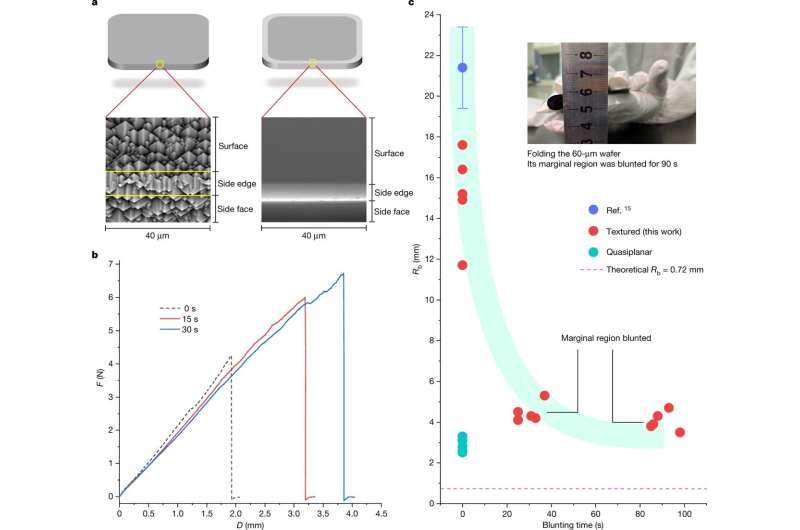Researchers create flexible monocrystalline silicon solar cells
A large team of technologists affiliated with multiple institutions in China, working with two colleagues from Germany and another two from Saudi Arabia, has found a way to create flexible monocrystalline silicon solar cells. In their study, reported in the journal Nature, the group developed and tested a new process. The editors at Nature have also published a Research briefing in the same journal issue, outlining the work by the team on this new effort.
Solar cells have been around for more than a half-century, providing electricity for a variety of clean energy applications. But to date, almost all of them have involved the use of flat, rigid solar cells, making them suitable for use in a limited number of applications. For many years, scientists, application developers and end users have waited for the development of flexible solar panels as efficient and durable as those that are rigid. In this new effort, the research team reports a way to create such a product.
The team began by running simulations of ideas to see if any might pan out. They came up with two techniques to treat the semiconductor materials used to make solar panels: the first was a wet chemical process, while the second was a dry, plasma-based process.
In real world testing, they proved that they could be used to create thin flexible panels—unfortunately, both suffered from excess reflectivity. Microscopic analysis showed that the problem was due to microscopic cracking between pyramid-shaped bumps that were created during processing on the surface of the panels. The team then found a way to soften the the bumps and channels that formed between the edges, where cracks formed. Further testing showed that cracks still formed, but the panel never broke, which allowed the cell to bend and remain usable.
Resulting devices made using the bendable cells were as efficient and durable as non-bendable cells. The research team also found that the cells could be easily mass produced. And because they are far lighter than traditional solar cells, they have many more applications.
More information:
Wenzhu Liu et al, Flexible solar cells based on foldable silicon wafers with blunted edges, Nature (2023). DOI: 10.1038/s41586-023-05921-z
Flexible solar cells made with crystalline silicon, Nature (2023). DOI: 10.1038/d41586-023-01357-7
© 2023 Science X Network
Citation:
Researchers create flexible monocrystalline silicon solar cells (2023, May 25)
retrieved 26 May 2023
from https://techxplore.com/news/2023-05-flexible-monocrystalline-silicon-solar-cells.html
This document is subject to copyright. Apart from any fair dealing for the purpose of private study or research, no
part may be reproduced without the written permission. The content is provided for information purposes only.

Comments are closed